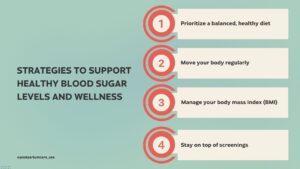If you were diagnosed with gestational diabetes during pregnancy, you’re not alone—and you’re not without support. This condition affects up to 10% of pregnancies in the U.S., but with the right postpartum care, you can take charge of your health and reduce your risk of complications.
In this blog post, we’ll answer:
- What is gestational diabetes?
- When does gestational diabetes go away?
- How to go about managing gestational diabetes postpartum?
- And how to reduce your risk of type 2 diabetes after pregnancy.
Whether you’re newly postpartum or months into recovery, understanding how to care for your body after previous gestational diabetes is key to feeling your best and protecting your long-term health.
What Is Gestational Diabetes?
Gestational diabetes is a form of glucose intolerance that develops during pregnancy, usually in the second or third trimester. It occurs when the body becomes less sensitive to insulin—the hormone responsible for helping glucose (sugar) move from the bloodstream into cells for energy. This resistance to insulin causes blood glucose levels to rise, a condition known as hyperglycemia.
While gestational diabetes is typically temporary, resolving after childbirth in most cases, its effects can linger long after delivery and increase the mother’s risk of future health problems.
Why Does It Happen?
During pregnancy, the placenta produces hormones that support the baby’s growth and development. Some of these hormones, like human placental lactogen (hPL), estrogen, and cortisol, can interfere with the action of insulin. As pregnancy progresses, these hormones increase, and so does insulin resistance. In response, the pancreas works harder to produce more insulin. When it can’t keep up with the increased demand, blood glucose levels rise, resulting in gestational diabetes.
Risk Factors for Developing Gestational Diabetes
Gestational diabetes can affect anyone, but several risk factors make some women more likely to develop it:
- A previous pregnancy with gestational diabetes
- Being overweight or having a high body mass index (BMI) (≥ 25 kg/m²)
- Family history of type 2 diabetes
- Polycystic ovary syndrome (PCOS)
- Being over the age of 25
- Belonging to certain ethnic groups (Hispanic, African American, Native American, South or East Asian, Pacific Islander)
- Having delivered a baby weighing more than 9 pounds in a previous pregnancy
- Sedentary lifestyle or poor healthy diet before or during pregnancy
Understanding your risk factors can help you take preventative steps early—especially if you’ve experienced gestational diabetes in a previous pregnancy.
Blood Glucose Monitoring and Diagnosis
Gestational diabetes is typically diagnosed between weeks 24 and 28 of pregnancy using an oral glucose tolerance test (OGTT). This test measures how efficiently your body processes sugar.
According to the Centers for Disease Control and Prevention (CDC), gestational diabetes affects up to 10% of pregnancies in the U.S. annually. Early detection is essential to protect both maternal and fetal health. If left unmanaged, high blood glucose levels can lead to complications such as:
- High birth weight (macrosomia)
- Preterm labor
- Preeclampsia
- Increased need for cesarean delivery
- Neonatal hypoglycemia (low blood sugar in the baby)
- Stillbirth (in severe untreated cases)
Does Gestational Diabetes Go Away?
For most women, gestational diabetes goes away after birth—once hormone levels normalize and the placenta is delivered. But here’s the part that often gets overlooked:
Up to 50% of women who experience gestational diabetes go on to develop type 2 diabetes later in life, particularly if no lifestyle changes are made postpartum (Source). That’s why postpartum follow-up and long-term monitoring are critical for prevention.
Lifestyle and Nutrition: Preventing Gestational Diabetes Mellitus
The good news? You have more power than you think. After delivery, implementing a healthy diet, regular movement, and weight management can dramatically lower your risk of developing type 2 diabetes.
Here are a few simple strategies to support healthy blood sugar levels and overall wellness after a previous pregnancy with gestational diabetes:
Prioritize a balanced, healthy diet
- Include complex carbs, lean proteins, and healthy fats
- Minimize processed foods and added sugars
- Eat at regular intervals to avoid blood sugar spikes and crashes
Move your body regularly
- Aim for at least 30 minutes of moderate activity most days
- Walking, postpartum yoga, and gentle strength training are great places to start
Manage your body mass index (BMI)
- Even a modest weight loss (5–7% of body weight) can reduce the risk of developing type 2 diabetes
Stay on top of screenings
- Follow your provider’s guidance for a postpartum blood glucose test
- Continue with regular check-ups, especially if you have a family history or additional risk factors

Remember: While gestational diabetes might be temporary, the risk of future complications is very real. Taking small, sustainable steps now can protect your long-term health, even if you have other risk factors, and set you up for a strong recovery after birth.
Next up: Let’s talk about what to expect at your postpartum follow-up and how to advocate for the lab work and support you deserve.
When Does Gestational Diabetes Go Away?
For many women, gestational diabetes mellitus (GDM) resolves shortly after delivery. As the placenta—which produces hormones that contribute to insulin resistance—is delivered, blood sugar levels often return to normal within a few days or weeks. However, this isn’t always the case.
In fact, some women continue to have impaired glucose tolerance postpartum, especially if they had more severe cases of GDM, required insulin during pregnancy, or had additional risk factors such as a history of PCOS, elevated body mass index (BMI), or a family history of type 2 diabetes.
This is why it’s crucial to follow up with postpartum glucose testing, usually performed between 6 to 12 weeks after birth. This test, often a 2-hour oral glucose tolerance test (OGTT), helps your provider determine whether your blood sugar has normalized or if you’re still at risk of developing diabetes.
The Link Between Gestational Diabetes and Future Health Risks
While gestational diabetes mellitus may be temporary, its implications can be long-lasting. Research shows that up to 50% of women with a history of gestational diabetes go on to develop type 2 diabetes within 5 to 10 years after childbirth. This risk increases with each future pregnancy, especially if gestational diabetes recurs.
But there’s good news! There’s a lot you can do to lower your risk.
Why Lifestyle Changes Matter After GDM
Even if your blood sugar levels return to normal after birth, adopting a healthy lifestyle is key to reducing your risk of perinatal complications in future pregnancies and preventing type 2 diabetes long-term.
Here’s how to support your body after gestational diabetes:
- Maintain a healthy weight: Losing just 5–7% of your body weight can significantly reduce your risk of developing diabetes.
- Eat a balanced diet: Focus on fiber-rich vegetables, whole grains, healthy fats, and lean protein to support steady blood sugar levels.
- Stay active: Aim for at least 150 minutes of moderate exercise each week—walking, swimming, and postpartum yoga are all great options.
- Get regular screenings: Even if your postpartum glucose test is normal, schedule follow-up testing every 1 to 3 years to stay on top of any changes.
Gestational diabetes may go away, but its shadow can linger. Understanding your risks and making mindful, sustainable changes can empower you to protect your health, now and for the future.
Gestational Diabetes Postpartum Glucose Testing
Your provider should schedule a gestational diabetes postpartum blood test about 6–12 weeks after delivery. This is typically a 2-hour oral glucose tolerance test (OGTT), which helps determine if your blood sugar levels have returned to normal or if you’re at risk of developing type 2 diabetes after pregnancy. Ongoing screening is essential, for women with gestational diabetes.
Symptoms of Diabetes After Pregnancy
In the whirlwind of caring for a newborn, it’s easy to brush off symptoms like exhaustion, frequent bathroom trips, or even mood changes as “just postpartum life.” But certain signs shouldn’t be ignored—especially if you had gestational diabetes during pregnancy.
If you’re experiencing:
- Persistent fatigue
- Excessive thirst
- Frequent urination
- Blurry vision
- Unexplained weight loss or gain
…it’s time to talk to your provider. These may be symptoms of diabetes after pregnancy—and catching them early can help you avoid long-term health issues. A simple blood test can check your fasting glucose and hemoglobin A1C levels to determine how well your body is processing sugar.
Gestational Diabetes Postpartum Complications and Follow-Up
Even after your baby is born, gestational diabetes postpartum complications can still arise. Women with a history of GDM are at a higher risk for high blood pressure, cardiovascular disease, and developing type 2 diabetes later in life. Postpartum follow-up is not just a formality—it’s an essential part of your health care.
A comprehensive gestational diabetes postpartum follow-up should include:
✅ Blood Sugar Monitoring
A postpartum glucose test (usually done 6–12 weeks after birth) is key to assessing whether your blood sugar has normalized. According to the American Diabetes Association, this screening helps catch lingering glucose intolerance or early signs of type 2 diabetes.
✅ Blood Pressure Checks
Women who had gestational diabetes are at increased risk for hypertension, including elevated systolic blood pressure. Monitoring your blood pressure regularly can help prevent complications like preeclampsia or stroke.
✅ Weight and Nutrition Counseling
Working toward a healthy weight can reduce your risk of developing type 2 diabetes by up to 50%. Nourishing your body with whole foods, lean protein, and healthy fats also supports energy, mood, and milk supply if you’re breastfeeding.
✅ Breastfeeding Support
Not only is breast milk incredibly beneficial for your baby, but studies show that breastfeeding may also help improve insulin sensitivity and support blood sugar regulation in postpartum women.
Managing gestational diabetes doesn’t end with delivery—it continues into the postpartum period, where smart choices and proactive care can make all the difference. Following up with your provider, prioritizing your health, and making sustainable lifestyle changes are powerful ways to protect your long-term well-being.
Even if your glucose levels have returned to normal for now, regular monitoring and ongoing support can help you feel empowered—not just as a mother, but as a woman taking charge of her health.
Gestational Diabetes and Postpartum Care: How to Stay Healthy
Managing your health after gestational diabetes means staying proactive. Here are a few things that help:
– Eat balanced meals with complex carbs, protein, and healthy fats
– Avoid long periods without eating to stabilize blood sugar
– Exercise regularly—walking, yoga, or strength training can help
– Prioritize sleep and stress management to keep cortisol in check
– Get regular lab work to track glucose and insulin levels
– Drink water throughout the day to maintain hydration and regulate glucose levels
Gestational Diabetes and Exercise
Physical activity is one of the best ways to manage blood sugar levels postpartum. Regular movement improves insulin sensitivity and supports overall hormone regulation. Start slow and consult with your provider if you had complications during delivery—but even 20 minutes a day can make a big difference.
Gestational Diabetes and Long-Term Risks
Gestational diabetes doesn’t always end with delivery. In fact, it can be a red flag for how your body handles blood sugar and insulin long term. Research shows that up to 50% of women with a history of gestational diabetes go on to develop type 2 diabetes within 5 to 10 years after giving birth. That’s why continued care and monitoring matter—your postpartum journey is the beginning of a new chapter, not the end of your health story.
Does Having Gestational Diabetes Mean You’re More Likely to Have Diabetes Later?
In short, yes. Gestational diabetes is one of the strongest predictors for developing type 2 diabetes later in life. While your blood sugar levels may return to normal shortly after delivery, the underlying insulin resistance often remains. Without intervention, this can quietly progress into chronic blood sugar dysregulation.
A simple blood sample taken at your postpartum follow-up visit can check for early signs of type 2 diabetes. If caught early, lifestyle changes and medical support can help you delay—or even prevent—the onset altogether.
Other Long-Term Concerns
- High blood pressure: Even if your readings were normal before or during pregnancy, GDM increases your lifetime risk of hypertension and related cardiovascular issues.
- Future pregnancies: If you had gestational diabetes once, your risk of developing it again in subsequent pregnancies is higher.
- PCOS: Women with polycystic ovary syndrome already face a higher risk of insulin resistance—and gestational diabetes can further complicate hormonal and metabolic balance.
The Good News?
These risks are not set in stone. A healthy diet, regular movement, stress reduction, and routine lab work can go a long way in preventing complications and supporting long-term wellness. Think of this as a chance to reconnect with your health—on your terms.
A Story from a Postpartum Mom Who Had Gestational Diabetes
After being diagnosed with gestational diabetes during her second pregnancy, Maria worked hard to follow her provider’s recommendations. She stayed active, adjusted her meals, and managed her blood sugar well.
After birth, she assumed she was in the clear—until her 6-week follow-up test showed lingering insulin resistance. Thanks to early detection, she was able to make sustainable changes and avoid a type 2 diabetes diagnosis.
Maria’s story is a powerful reminder of how important that postpartum follow-up can be, and unfortunately, a screening test from your primary care doctor or OBGYN is not always interpreted thoroughly. Medical care in the United States is fun like that…
That’s why at Postpartum Care USA, we check over 55 biomarkers to detect signs of inflammation, poor glycemic control, elevated cortisol and more factors that could put you at risk for developing this lifelong condition.
Many of our packages also offer a consultation with a registered dietitian, so you can make sure the dietary changes you make are in line to set you up for a healthy lifestyle whether you plan on a next pregnancy or not!
Final Thoughts
How many women recover from gestational diabetes after delivery? Most—but that doesn’t mean you should skip the follow-up. With the right support and proactive care, you can recover fully and reduce your risk of future health issues.
If you had gestational diabetes, don’t wait. Prioritize your postpartum testing, talk with your care team, and take charge of your long-term wellness. You’ve got this, mama.
Pin This for Later:



Postnatal Depletion
Meet the Team
Our Services
Supplements
A virtual healthcare clinic that helps postpartum mamas recover from postnatal depletion syndrome with a holistic approach.

Get in touch